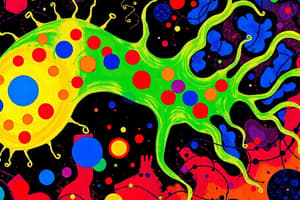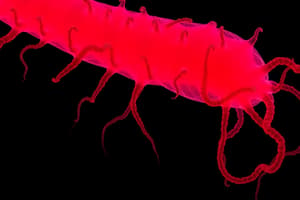Podcast
Questions and Answers
Which species of Entamoeba is associated with invasive disease in humans?
Which species of Entamoeba is associated with invasive disease in humans?
- Entamoeba polecki
- Entamoeba coli
- Entamoeba histolytica (correct)
- Entamoeba dispar
What is the global rank of amebiasis as a cause of death due to parasitic diseases?
What is the global rank of amebiasis as a cause of death due to parasitic diseases?
- Fourth
- First
- Second
- Third (correct)
How does Entamoeba dispar compare to Entamoeba histolytica in diagnostic tests?
How does Entamoeba dispar compare to Entamoeba histolytica in diagnostic tests?
- E. dispar is more virulent.
- It shows distinct differences.
- E. dispar is always misdiagnosed.
- They are identical in conventional testing. (correct)
What percentage of the world's population is estimated to be infected with Entamoeba species?
What percentage of the world's population is estimated to be infected with Entamoeba species?
Which of the following statements about Entamoeba species is true?
Which of the following statements about Entamoeba species is true?
Which statement accurately reflects the relationship between Entamoeba species and human disease?
Which statement accurately reflects the relationship between Entamoeba species and human disease?
What is a significant implication of the global infection rates of Entamoeba species?
What is a significant implication of the global infection rates of Entamoeba species?
Which factor contributes to the global significance of Entamoeba histolytica?
Which factor contributes to the global significance of Entamoeba histolytica?
What distinguishes Entamoeba dispar from Entamoeba histolytica?
What distinguishes Entamoeba dispar from Entamoeba histolytica?
In terms of global prevalence, what is an accurate statistic about the population infected with Entamoeba?
In terms of global prevalence, what is an accurate statistic about the population infected with Entamoeba?
Which of the following statements is true regarding Entamoeba species?
Which of the following statements is true regarding Entamoeba species?
What factor contributes to amebiasis being a leading cause of death from parasitic disease?
What factor contributes to amebiasis being a leading cause of death from parasitic disease?
How does the diagnostic testing for Entamoeba histolytica and Entamoeba dispar compare?
How does the diagnostic testing for Entamoeba histolytica and Entamoeba dispar compare?
What is a significant characteristic of Entamoeba dispar regarding human health?
What is a significant characteristic of Entamoeba dispar regarding human health?
What implication does the statistic of 10% global infection with Entamoeba have on public health?
What implication does the statistic of 10% global infection with Entamoeba have on public health?
Flashcards
Entamoeba histolytica
Entamoeba histolytica
A species of amoeba that causes invasive disease in humans, leading to amebiasis.
Amebiasis
Amebiasis
A parasitic disease caused by Entamoeba histolytica, a major global health issue.
Entamoeba dispar
Entamoeba dispar
A type of amoeba that colonizes humans, but does not cause disease in humans; similar to E. histolytica in tests.
Global infection rate
Global infection rate
Signup and view all the flashcards
Entamoeba species
Entamoeba species
Signup and view all the flashcards
Global prevalence
Global prevalence
Signup and view all the flashcards
Why is Entamoeba dispar a challenge?
Why is Entamoeba dispar a challenge?
Signup and view all the flashcards
Diagnostic Challenge
Diagnostic Challenge
Signup and view all the flashcards
Study Notes
Protozoan Infections: Entamoeba
- Numerous Entamoeba species exist; most don't cause human disease, but Entamoeba histolytica does.
- Amebiasis, caused by E. histolytica, is the third leading cause of death from parasitic diseases globally.
- Entamoeba dispar is identical to E. histolytica in diagnostic tests, colonizes humans, but doesn't cause disease.
- An estimated 10% of the world's population is infected with either E. histolytica or E. dispar.
- Less than 10% of infected individuals develop symptomatic disease.
- Around 50 million people develop amebiasis each year, with approximately 100,000 deaths annually.
- In the USA, about 4% of the population is infected with either E. histolytica or E. dispar.
Susceptible Groups
- Pregnant women
- Children
- Individuals with lower economic status
- People living in crowded conditions
- People living in areas with poor sanitation
Life Cycle of Entamoeba histolytica
- E. histolytica exists as a trophozoite and a cyst.
- Infection occurs through the fecal-oral route, with cysts being ingested.
- Cysts excyst in the small intestine, releasing trophozoites that colonize the large intestine.
- Trophozoites encyst, forming cysts that are released in feces.
- Cysts can survive in the environment for weeks to months and can withstand freezing and chlorination.
- During acute disease, trophozoites may also be shed in the feces, but these aren't as resilient as cysts and can't survive long outside the body, being killed by stomach acid if ingested.
Clinical Manifestations
- Asymptomatic intestinal colonization: 90% of those infected will be asymptomatic carriers, passing cysts in their stool for up to a year.
- Symptoms (10% of cases):
- Acute amebic colitis
- Chronic amebic colitis
- Fulminant amebic colitis
- Extra-intestinal Sites: Liver, lung, brain, and genitourinary tract.
Specific Syndromes
-
Acute amebic colitis: Lower abdominal pain, diarrhea, loose to watery stools with blood and mucus over several weeks.
-
Chronic amebic colitis: Persistent low-grade inflammation, intermittent bloody diarrhea, and abdominal pain, sometimes lasting for months or years. Often confused with inflammatory bowel disease.
-
Fulminant amebic colitis: Rare, primarily in children. Characterized by diffuse abdominal pain, bloody diarrhea, frequent colonic perforations, toxicity megacolon, liver abscess, and a mortality rate approaching 50%.
-
Amebic Liver Abscess: Most common extra-intestinal form of amebiasis. Often associated with upper right quadrant pain (sometimes misdiagnosed as pain in the right shoulder), fever, and occasionally an enlarged liver. Jaundice is uncommon.
-
Other Complications: Pleuro-pulmonary and peritoneal amebiasis, a rare but serious issue. Pericardial amebiasis may follow the rupture of an abscess in the liver's left lobe.
-
Cerebral Amebiasis: Rare, seen in less than 0.1% of patients from clinical studies. May present through neurological symptoms or mental status changes.
Diagnosis
- Detection of cysts or trophozoites in stool or biopsy specimens.
- Trophozoites are delicate to antibiotics, antidiarrheal agents, barium, and tap water. Properly prepared wet mounts should be examined within 20 minutes of sample collection.
- Serology may be used to detect antibodies to E. histolytica (but not E. dispar). Antibodies are usually apparent within 7-10 days in infected individuals; however they can persist for years, sometimes meaning a current infection cannot be distinguished from a past infection.
- Monoclonal antibodies and PCR can distinguish E. histolytica from E. dispar.
Treatment
- Treatment is twofold: eliminate trophozoites from intestines and any extra-intestinal sites, eliminate cysts from the intestine.
- Metronidazole is the preferred drug for trophozoites.
- Tetracycline or erythromycin are options for milder cases but are ineffective against liver amoebae.
- Cysts are treated with luminal agents like diloxanide furoate (obtainable from the CDC), iodoquinol, or paromomycin.
Prevention and Control
- Effective sanitation and clean water supplies are crucial, as amoebae can be resistant to chlorination.
Studying That Suits You
Use AI to generate personalized quizzes and flashcards to suit your learning preferences.




